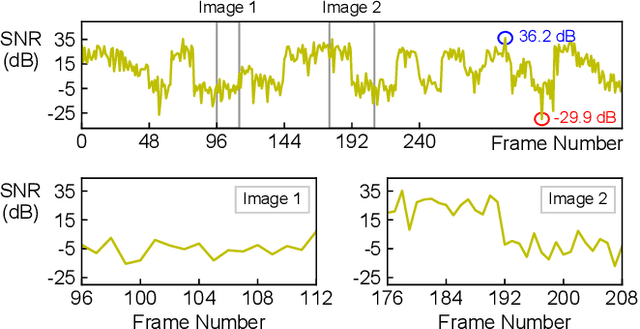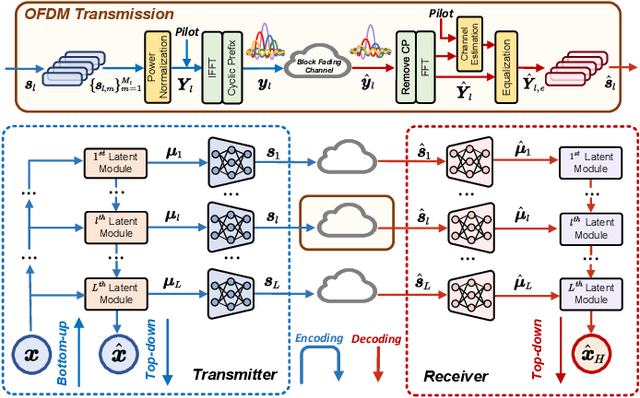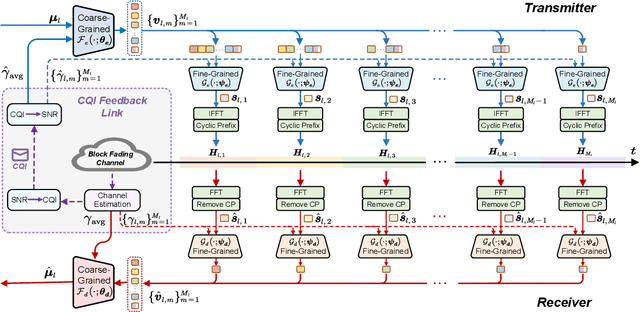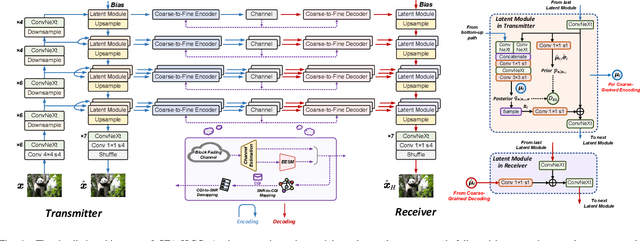Kequan Zhou
ROME: Robust Model Ensembling for Semantic Communication Against Semantic Jamming Attacks
Jan 02, 2025Abstract:Recently, semantic communication (SC) has garnered increasing attention for its efficiency, yet it remains vulnerable to semantic jamming attacks. These attacks entail introducing crafted perturbation signals to legitimate signals over the wireless channel, thereby misleading the receivers' semantic interpretation. This paper investigates the above issue from a practical perspective. Contrasting with previous studies focusing on power-fixed attacks, we extensively consider a more challenging scenario of power-variable attacks by devising an innovative attack model named Adjustable Perturbation Generator (APG), which is capable of generating semantic jamming signals of various power levels. To combat semantic jamming attacks, we propose a novel framework called Robust Model Ensembling (ROME) for secure semantic communication. Specifically, ROME can detect the presence of semantic jamming attacks and their power levels. When high-power jamming attacks are detected, ROME adapts to raise its robustness at the cost of generalization ability, and thus effectively accommodating the attacks. Furthermore, we theoretically analyze the robustness of the system, demonstrating its superiority in combating semantic jamming attacks via adaptive robustness. Simulation results show that the proposed ROME approach exhibits significant adaptability and delivers graceful robustness and generalization ability under power-variable semantic jamming attacks.
Towards Compatible Semantic Communication: A Perspective on Digital Coding and Modulation
Dec 25, 2024



Abstract:Semantic communication (SC) is emerging as a pivotal innovation within the 6G framework, aimed at enabling more intelligent transmission. This development has led to numerous studies focused on designing advanced systems through powerful deep learning techniques. Nevertheless, many of these approaches envision an analog transmission manner by formulating the transmitted signals as continuous-valued semantic representation vectors, limiting their compatibility with existing digital systems. To enhance compatibility, it is essential to explore digitized SC systems. This article systematically identifies two promising paradigms for designing digital SC: probabilistic and deterministic approaches, according to the modulation strategies. For both, we first provide a comprehensive analysis of the methodologies. Then, we put forward the principles of designing digital SC systems with a specific focus on informativeness and robustness of semantic representations to enhance performance, along with constellation design. Additionally, we present a case study to demonstrate the effectiveness of these methods. Moreover, this article also explores the intrinsic advantages and opportunities provided by digital SC systems, and then outlines several potential research directions for future investigation.
Coarse-to-Fine: A Dual-Phase Channel-Adaptive Method for Wireless Image Transmission
Dec 11, 2024



Abstract:Developing channel-adaptive deep joint source-channel coding (JSCC) systems is a critical challenge in wireless image transmission. While recent advancements have been made, most existing approaches are designed for static channel environments, limiting their ability to capture the dynamics of channel environments. As a result, their performance may degrade significantly in practical systems. In this paper, we consider time-varying block fading channels, where the transmission of a single image can experience multiple fading events. We propose a novel coarse-to-fine channel-adaptive JSCC framework (CFA-JSCC) that is designed to handle both significant fluctuations and rapid changes in wireless channels. Specifically, in the coarse-grained phase, CFA-JSCC utilizes the average signal-to-noise ratio (SNR) to adjust the encoding strategy, providing a preliminary adaptation to the prevailing channel conditions. Subsequently, in the fine-grained phase, CFA-JSCC leverages instantaneous SNR to dynamically refine the encoding strategy. This refinement is achieved by re-encoding the remaining channel symbols whenever the channel conditions change. Additionally, to reduce the overhead for SNR feedback, we utilize a limited set of channel quality indicators (CQIs) to represent the channel SNR and further propose a reinforcement learning (RL)-based CQI selection strategy to learn this mapping. This strategy incorporates a novel reward shaping scheme that provides intermediate rewards to facilitate the training process. Experimental results demonstrate that our CFA-JSCC provides enhanced flexibility in capturing channel variations and improved robustness in time-varying channel environments.
Feature Allocation for Semantic Communication with Space-Time Importance Awareness
Jan 26, 2024Abstract:In the realm of semantic communication, the significance of encoded features can vary, while wireless channels are known to exhibit fluctuations across multiple subchannels in different domains. Consequently, critical features may traverse subchannels with poor states, resulting in performance degradation. To tackle this challenge, we introduce a framework called Feature Allocation for Semantic Transmission (FAST), which offers adaptability to channel fluctuations across both spatial and temporal domains. In particular, an importance evaluator is first developed to assess the importance of various features. In the temporal domain, channel prediction is utilized to estimate future channel state information (CSI). Subsequently, feature allocation is implemented by assigning suitable transmission time slots to different features. Furthermore, we extend FAST to the space-time domain, considering two common scenarios: precoding-free and precoding-based multiple-input multiple-output (MIMO) systems. An important attribute of FAST is its versatility, requiring no intricate fine-tuning. Simulation results demonstrate that this approach significantly enhances the performance of semantic communication systems in image transmission. It retains its superiority even when faced with substantial changes in system configuration.
FAST: Feature Arrangement for Semantic Transmission
May 05, 2023



Abstract:Although existing semantic communication systems have achieved great success, they have not considered that the channel is time-varying wherein deep fading occurs occasionally. Moreover, the importance of each semantic feature differs from each other. Consequently, the important features may be affected by channel fading and corrupted, resulting in performance degradation. Therefore, higher performance can be achieved by avoiding the transmission of important features when the channel state is poor. In this paper, we propose a scheme of Feature Arrangement for Semantic Transmission (FAST). In particular, we aim to schedule the transmission order of features and transmit important features when the channel state is good. To this end, we first propose a novel metric termed feature priority, which takes into consideration both feature importance and feature robustness. Then, we perform channel prediction at the transmitter side to obtain the future channel state information (CSI). Furthermore, the feature arrangement module is developed based on the proposed feature priority and the predicted CSI by transmitting the prior features under better CSI. Simulation results show that the proposed scheme significantly improves the performance of image transmission compared to existing semantic communication systems without feature arrangement.
 Add to Chrome
Add to Chrome Add to Firefox
Add to Firefox Add to Edge
Add to Edge